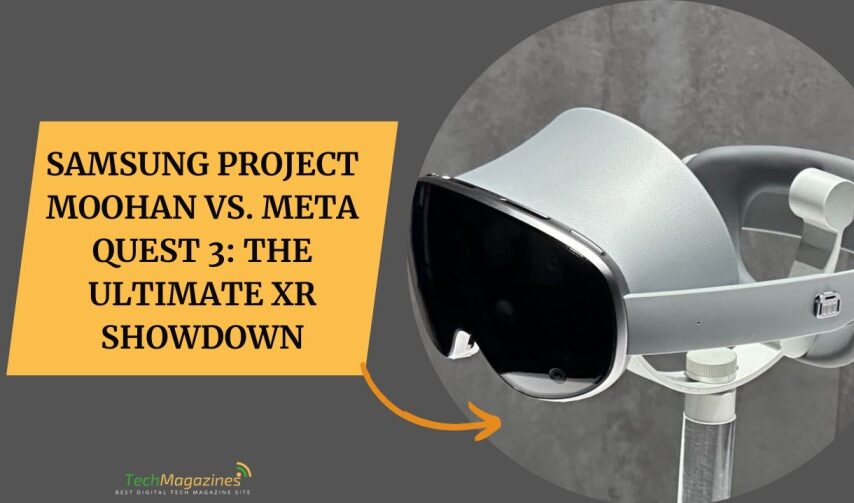Samsung’s Project Moohan turned heads when it was announced with Android XR, a new breed of Android made for AR glasses, VR headsets, and mixed reality gear. This headset is built to merge the real and the unreal, for work and for play—like the Meta Quest 3, but different. The name will change before launch.
Samsung showed the machine for the first time at Unpacked 2025, alongside the Galaxy S25. It looked solid. Strong. They say it will outmatch the Quest 3. They say it will be the best yet. Good hardware. A price that cuts below the Apple Vision Pro. But will it truly be the better machine? Let’s see.
Design and Comfort: Which Headset Feels Better?
Samsung’s Project Moohan and the Meta Quest 3 are both mixed reality headsets, but they fit differently. The Quest 3 is built cheap to stay under $500. It has a plastic shell and a thin cloth strap. It works, but it isn’t comfortable. Project Moohan feels better. Looks better. Some plastic keeps it light, but it’s built more like a Meta Quest Pro. Solid side straps. A wheel at the back to tighten. Thick, soft padding for the forehead and the back of your head.
Unlike the Quest 3, Moohan doesn’t press on your face. The rubber light blockers snap on and off with magnets. Samsung hasn’t shown them yet, but they promise comfort. The Quest 3’s strap spreads weight across your face and head. Some don’t mind. Others do. Those people buy better straps. Better padding. Anything to make it fit right. At first, this seems bad. But Meta built the Quest 3 to be changed. You can swap the strap, the face pad, and more. It’s not clear if Project Moohan will work the same way.
The Quest Pro had a problem—its strap and battery couldn’t be removed. You had to add things instead of replacing them. That made it worse. Maybe Samsung learned from Meta’s mistake. Moohan has automatic IPD adjustment. Eye tracking sets the right distance the moment you put it on. No guessing. No fiddling. Other headsets make you do it yourself. Some, like the PlayStation VR2, help with a guide. The Quest 3 makes you know your number first. It’s easy to adjust—just turn the wheel under the headset. But you still have to know it before you start.
The Meta Quest 3 comes with two controllers—one for each hand. Each has a joystick, three buttons, a trigger, and a grip button. It also supports hand tracking, so you don’t always need controllers. Samsung’s Project Moohan will support both, too. But Samsung hasn’t said if controllers come in the box or if you’ll have to buy them. Apple Vision Pro launched without controllers. No way to track motion. People complained. Apple had to add support later. Some games and experiences just need them.
Software and Features: Android XR vs. Meta Horizon OS
Meta Horizon OS runs Meta Quest headsets. It’s built on Android and always has been. Samsung’s Project Moohan runs on Android XR, another Android made for XR devices. They seem alike, but they aren’t. Both come from the Android Open Source Project, but Meta has spent years building its own layers. So many that it calls Horizon OS a separate system. Now, Meta lets other companies use it for their own headsets.
Horizon OS is built around the Meta Horizon world. It pushes Meta’s metaverse app and ties in Meta services. WhatsApp, Messenger, Facebook, and Instagram all have their own apps. Other apps exist, but Quest headsets are still mostly for games. Android XR is different. It runs on Google services, like most Android builds. Google calls it the first version of Android for the Gemini era. That means Gemini AI can run the whole system—if you let it.
Google says Gemini can see what you see. The real world. The virtual world. It can answer questions. Move things. Change screens as you need. It could change everything. But no one knows for sure. We wait for launch. Both systems support multitasking. Open many windows. Place them in space. Move them like floating monitors. Touch them like a phone or tablet. Android XR has the Google Play Store. That means Project Moohan should launch with more apps than the Meta Quest ever had. But Quest has the games. Thousands of them. Many won’t come to Android XR, at least not soon. Meta paid for some of the best. They won’t switch sides easily.
Performance and Technical Specs: Which XR Headset Packs More Power?
https://twitter.com/theshortcut/status/1884326579557310881
The Meta Quest 3 and Samsung Project Moohan run on Qualcomm Snapdragon chips. But Moohan has the stronger one—the Snapdragon XR2+ Gen 2. More power. Better cameras. Sharper displays. Neither matches a laptop chip like the one in Apple Vision Pro, but both are fast. Like a 2023 flagship phone, built for tracking movement and space.
Some of Moohan’s specs are known. Others are not. RAM, storage, display resolution—still a mystery. But rumors say it uses micro-OLED panels with up to 3,000 DPI. The Quest 3 has LCD panels with around 1,200 DPI. Both use pancake lenses. But Moohan’s lenses have eye tracking.
That gives it an edge. It uses foveated rendering—sharpening the center of your vision while cutting detail elsewhere to save power. Quest 3 tries something similar. Fixed foveated rendering. But without eye tracking, it’s less precise. The edges blur more. The image suffers.
Final Verdict: Should You Wait for Moohan or Buy the Quest 3?
You can’t buy Samsung Project Moohan yet, so this one’s easy. Right now, the Meta Quest 3 is the best VR headset for the price. It has the most games. It works on its own—no PC, no extra screen. All for $499. A solid deal. Moohan will have better hardware. No doubt about that. But it won’t be cheap. Rumors say $999. Maybe more. We’ll know later this year. If you want XR today, get the Quest 3. It has the games. It has the apps. It even streams Windows desktops. It’s ready now. Moohan is not.
Conclusion
In the end, although Samsung’s Project Moohan seems to be the better dressed at the XR family reunion, Meta Quest 3 is the one having the most fun. Yes, Moohan has the high-quality micro-OLED displays and eye-tracking features as its main selling points, but it is arriving at a party that Meta has been hosting for years. With a speculated $999 price, Moohan will have to do more than just having pretty pancake lenses to capture the attention of consumers from the Quest 3 which already has a set platform. For now, Meta’s $499 headset is the one that makes the most sense – unless you’re willing to wait for Samsung’s vision of the future while your wallet considers the matter.
FAQs
Q1: What exactly is Project Moohan?
A: Project Moohan is Samsung’s next-generation mixed reality headset, but it goes by that name for now only. It is Samsung’s version of Meta Quest 3 that comes with the Android XR operating system. It is, therefore, seen as Samsung’s effort to offer premium XR at a more affordable price than the Apple Vision Pro. It was first introduced at Samsung Unpacked 2025 event and overshadowed the Galaxy S25.
Q2: How does Project Moohan’s comfort level compare to Meta Quest 3?
A: It is like wearing a cloud as opposed to having a brick tied to one’s face. Project Moohan has a soft padding and a fancy wheel adjustment mechanism while the Quest 3 comes with a cloth strap. However, Quest 3 can change parts such as Mr. Potato Head which may not the case with Moohan’s customization.
Q3: What’s the deal with Android XR versus Meta Horizon OS?
A: Imagine Android wearing a VR headset as opposed to Facebook’s version of The Matrix. Both operating systems are based on Android; however, Android XR is equipped with Google’s Gemini AI as your personal assistant in the digital and physical worlds. Meta Horizon OS is, however, like Facebook’s teenage bedroom – covered in Meta apps and services from head to toe. Each has its advantages and disadvantages, but Android XR might take the lead in the number of apps due to Google Play Store availability.
Q4: Is Project Moohan worth waiting for, or should I just get a Quest 3?
A: If you are eager to jump into the XR right now and your pockets are not deep enough to afford the premium devices, the Quest 3 at $499 is the best you can get. It’s akin to purchasing a car from Toyota which has a wide range of spare parts in the market. Project Moohan which is believed to cost $999 is more of a design study or a show car that is not even on the drawing board.








